How to Politely Say No to Customers: 10 Best Tips & Examples
- May 25, 2016
- 18 mins read
- Listen
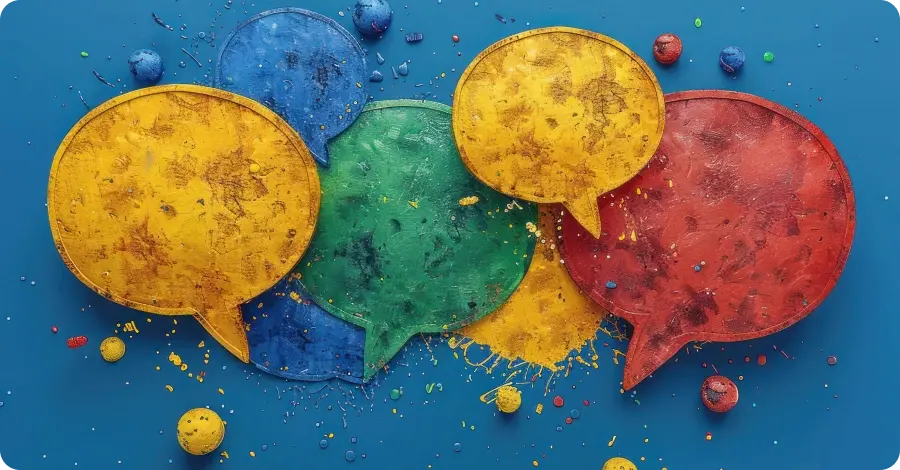
Table of Content
Telling customers “No” is one of the toughest challenges faced by any company. No one likes to say no, especially to the customers, and customer service agents often find themselves feeling caught between delivering a satisfying experience and declining certain customer requests due to the company’s policies. The pain points are real: there is a fear of making a loyal customer angry, the worry of getting negative reviews, and the risk of losing valued customers. Whether it’s declining a discount request, or other unrealistic expectations, saying “no” is really difficult.
So, in order to handle these scenarios efficiently, you need to strike a balance between saying no to customers and still keeping them engaged with the business. The best possible response will be to hear what customers say, show interest in their demands, and then respond to them in a positive manner.
In this blog article, we will explore some of the practical strategies to help you say no to customers while still maintaining a strong relationship. We will also cover some key phrases and examples to help you handle these situations with confidence. Let’s get started!
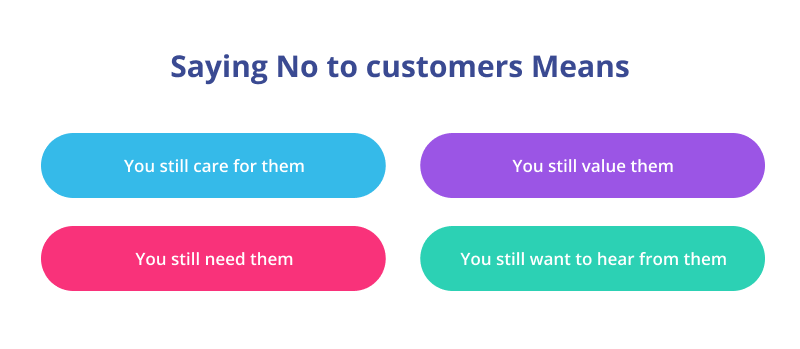
Why It’s Important to Say No to Customers in a Polite Way
In customer service, saying “no” is often one of the hardest things to do. Customers reach out to your brand in the hope of getting a solution, and declining their requests can feel like a failure to meet their expectations. But many times, due to company policies, product availability, or other unavoidable reasons, saying “no” becomes necessary. But how you can deliver this message, makes all the difference.
There are many reasons to remain polite, even when you have to tell customers no, including:
1. Preserving a Positive Brand Image
How you say “no” can shape how customers perceive your brand. A polite and empathetic “no” reflects a professional and customer-focused approach, even if you can’t meet the specific request. If customers feel valued and respected in every interaction, they are more likely to have a positive impression of the brand.
2. Maintaining Customer Trust and Loyalty
Saying “no” politely is a good way to reinforce trust with the customers. When you respond empathetically, acknowledging the customer’s needs while also setting realistic expectations, it shows transparency and honesty. Even if you can not offer what they want, they will appreciate your honesty.
3. Managing Customer Expectations
When you politely decline a customer request, it also helps to set clear and realistic expectations. If customers understand your limitations, they will never get frustrated and hurt. For example, if a customer is requesting a service outside your company policy, a polite refusal, paired with an explanation, should work.
4. Turning a Negative into a Positive Experience
If you can handle one customer request that can’t be fulfilled with empathy and politeness, your “no” doesn’t have to lead to a negative customer experience. Instead, it’s an opportunity to show your commitment to finding an alternative solution, even if it’s outside the customer’s original request. By offering other options, such as a different product, service, or time slot for example, you show your willingness to offer the best services to him.
5. Reducing the Risk of Getting Negative Feedback
Disappointed customers may leave negative feedback. A polite and empathetic response can make all the difference. Even if they don’t get what they want, customers are less likely to spread negative reviews if you respond to them respectfully. A courteous “no” many times decreases the risk of customer backlash and negative public feedback.
10 Best Ways to Say “No” to Customers
It’s never easy to tell customers no, especially to those who you see as a prospect. Luckily, there are some effective strategies to serve the intended purpose without having to deny anyone. You can also learn how to decline a request politely and handle angry customers without offending someone and still benefit from the situation.
There are many ways you can say no to clients and still hope to retain their benevolence. Let’s dive into each of the ways in detail:
1. Thank Customers Before Replying
Start with thanking the customer for getting in touch with your brand. Such an opening gesture shows that you acknowledge the customer’s effort in reaching out and sets a positive tone for further conversation. It helps you to ease the situation when you say something that they may not want to hear.
Example: “I fully understand your perspective and want to start by thanking you for being a valued customer and for bringing this issue to our attention.”
REVE Chat is a great AI-powered customer service tool, that lets you communicate with your customers, listen to their concerns in real-time, and provide solutions. With REVE Chat, you can offer instant assistance on your websites, mobile apps and other social media platforms such as Facebook, Instagram, Telegram, Viber and WhatsApp.
To try out, SIGN UP for its 14-day free trial today!
2. Understand the Root Cause of Problems
Some of your customers may come up to you with a request that might seem bizarre to you or, a demand that looks unreasonable to meet.
In such cases, you might feel tempted to forsake any customer service etiquette to answer them in a negative way and finish off the matter in a jiffy. It would however be a mistake to immediately say no to customers without knowing the problem inside out.
The right response is to first get to the root of the problem, properly understand the motivation behind the request, and then think of the next course of action.
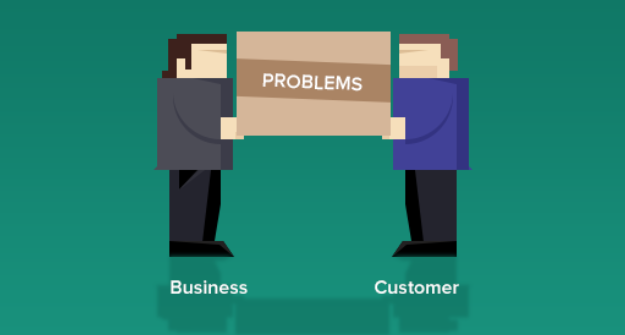
Let’s take one scenario: You are an online retail shop that recently discontinued the cash-on-delivery (COD) system for one particular area of the market for some strategic reasons. Now, when one of your customers wants the service back and approaches you with the request.
Even if you don’t intend to roll back the COD anytime soon, you could still be polite with the customer, suggest the benefits of the available option, and may even assure them of the return of the service in the near future.
Tips to Understand the Root Cause of Problems:
- Encourage the customer to give an opinion on how to make the system better as this will give an impression that they are valued by your business.
- If you can’t solve the existing problem, offer an alternative solution so that the customer feels good.
- Maintain a helping demeanor so that the customer feels like they matter to your business.
3. Listen First and Then Reply
Customers can reach your business from many channels.
And if you don’t have an appropriate customer response system in place, it will be difficult to manage conversations effectively.
When you’re ready to listen to what customers have to say, it means you’re ready to serve them better.
The right approach is to take customer communications seriously, attend to their request immediately, and then proactively reach out for help.
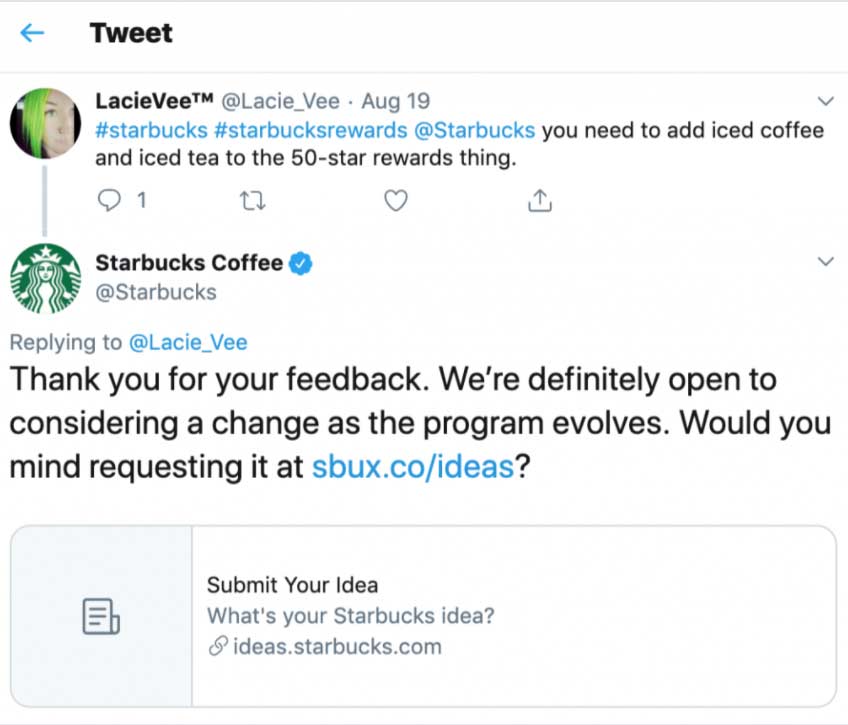
For example, Starbucks knows how to give value to customers and the above example is a clear case of its approach to solving problems.
How to Listen to Your Customers?
- Don’t let any customer message go unanswered and even if there is an angry outburst, make sure you attend to the conversations as soon as possible.
- Implement a multi-channel approach so that customers can find more ways to present their issues in front of your business
- Make sure you proactively help your customers so that they feel valued.
4. Explain Things in Detail
Customers ideally want to hear a “YES” when they approach brands with a request. And when they don’t get a favorable response, they wish to at least know the rationale behind the denial.
If you are in a situation where an affirmative answer from you is not possible, make sure you explain to customers the reason behind that.
Saying ‘No’ without explanation can make your customers feel upset and frustrated. This can might also dilute your customer relationship management effort in a big way.
However, if there is a detailed explanation, it can definitely make the frustration a little less stingy for sure.
So, if you want to understand how to politely decline a business request, give a proper reason for the denial.
Here are some of the examples of how to say no to customer requests by explaining things in detail:
“We are sorry to meet your request at the moment due to an ongoing service issue at our end. The moment our process is restored, we will get back to you and take things further from there….”
“The request you have made falls outside the purview of our company policy. We understand your issue but are bound by the rules.…”
“Serving you has always been a privilege to us. This time around we would have liked to make available the feature you requested but are unable to do it due to maintenance work at our end.”
5. Frame Your Response Carefully
Customers always like a great experience with brands. And they also expect businesses to respond in a positive manner.
So, even if you intend to say no, make sure your response is framed with some care to avoid any damage to customer goodwill with your business.
After all, more than your intent, the word you use, and the tone you choose to respond will linger on with customers.
For that reason, you should avoid a denial outright and rather be diplomatic in terms of interacting with them.
Here are some of the examples of how to tell a customer you cannot help them and still frame your response gracefully:
“We appreciate your time and effort in sharing with us. Unfortunately, we’re unable to implement this right way, but you can still be hopeful for the future…”
“Thanks to you for bringing our attention to this issue. Let us see what we can do best for this situation.”
“The reason we’re not able to offer this is that….”
How to Frame Your responses Gracefully?
- Be always careful with the words you choose for customers. And if possible, replace “no” with positive words.
- When dealing with customers, always maintain politeness so that a bad vibe is never passed down.
- To ensure the best possible response, make sure you hear customers inside out, see through their problems, and then go about responding to them.
6. Be Empathetic
Brands that follow the policy of empathy are more likely to retain the trust of their customers.
So, whenever your business has to say no to customers, make sure it comes with a sense of empathy otherwise you might come across as rude.
The focus should be on putting yourself in the customer’s shoes and then realizing the value of their concerns.
If you’re able to empathize with customers, you’re almost likely to get them returned convinced.
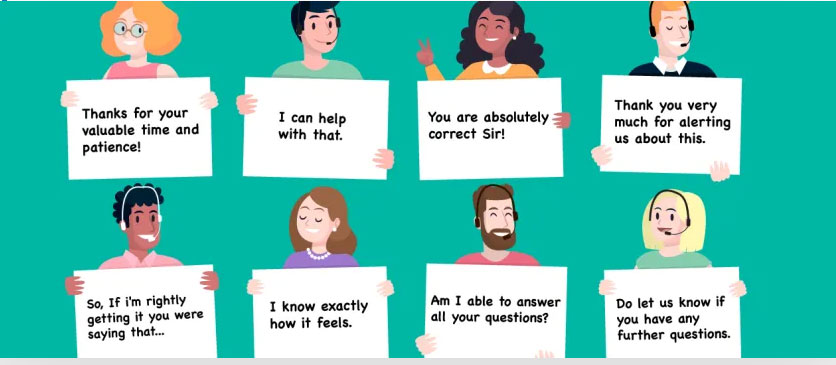
Best Practices:
- Never doubt the customer’s concerns as they may have come to you with certain expectations and make sure you find some value in their request.
- Maintain a professional demeanor in dealing with customers in situations when you have to turn down customers without coming across as curt.
- Mirro the tone of customers to look genuinely empathetic and always try to give customers the space to pour their heart out without feeling unwanted.
7. Offer an Alternative
There may be situations when you feel more than capable yet are unable to meet the exact demands of the customer for some reason.
On top of that, you also don’t want to deny customers a request that is not that steep.
For such scenarios, you can offer alternatives to customers and minimize their pain to some extent.
And by offering alternatives to customers, you not only avoid the situation of how to decline a request politely but also make them feel valued.

Benefits of Offering Alternatives to Customers
- Implementing the policy of alternatives can help your business achieve higher customer satisfaction and trust.
- Customers always want to feel valued, and giving them an alternative rather than rejecting them can make them return to you again.
- Customer churn will be minimized when you have a policy of giving options and showing concern to their problems.
8. Avoid Standard Responses
If your business is tarring all the customers with the same brush, it’s definitely heading on the wrong track. After all, customers want to feel unique in all situations and a standard response does not fit well into that narrative. Worse still, they generally feel bad when brands offer them templated responses for concerns.
So, even when you have to deny a customer, make sure the response does not feel like the one you have a “copy and paste” system as it might fail to convey the right message.
How to Avoid Standard Responses to Customers?
- Rather than offering a template message to customers, you can be honest about the situation and clearly tell your inability to meet their request at the moment.
- For situations where standard response becomes necessary, you can be genuine and offer an apology for putting the customers through this.
9. Seek Customer Feedback
Customer feedback should matter to your business, more than many other things. It will show that you look to handle customer complaints at all times. If you want to create happy customers, there is no way you can avoid seeking feedback.
More importantly, if you have been dealing with saying no to customers more often than you’d ideally prefer, it means your feedback mechanism is faulty. One major advantage of seeking customer feedback is to avoid situations in the future when you have to turn down customers.
Popular Customer Feedback Methods:
- Live Chat – Using chat surveys could be one of the best methods for collecting customer feedback because live chat is now a top channel preferred by customers to reach out to businesses.
- Social Media Monitoring – Customers love social sites to reach out to businesses, so you need to monitor popular channels to meet their requirements efficiently.
- Customer Interviews – When your business reaches a position to say no to customers, it can use that moment to its advantage by collecting feedback and implementing the changes.
10. Take Follow-ups
After having said no to a customer, you may feel like being in the wrong in some way. You, however can use this situation to your advantage and delight customers again with proper follow-ups.
Rather than waiting to hear back from customers after a denial of service, you should be proactive and take the first step in reaching out to them. A follow-up will help you recognize the customer signals and give you a roadmap in creating value for the business.
With a timely follow-up call, you can not only better understand what your customers want but can use the input to improve your customer support process.
When to Say “No” to Customers?
Before you start exploring how to say no to your customer requests or demands, let’s first understand when you need to decline. Knowing when to say “no” is essential for maintaining a healthy balance between delivering great service and managing business limitations. Here are some situations where a polite but firm “no” might be necessary:
- Customer Request that Goes Against Company Policy
If a customer asks for something that goes against your established company policies, such as a refund as many companies don’t offer this, a “no” may be necessary. Policies are in place to ensure fairness, consistency, and business integrity, so it’s important to communicate why such requests can’t be accommodated.
- When a Customer Becomes Rude
To maintain a safe and respectful environment in the workplace, its important to set boundaries between your business and customers. If a customer becomes aggressive, threatens your staff, or uses inappropriate language, it’s important to use your skills to politely say “no.” In extreme cases, you may need to end doing business with aggressive customers to protect your team and uphold a positive workplace atmosphere.
- When the Request Is Unrealistic
Many times, customers have unrealistic demands like impossible delivery timelines, deals, discounts etc. In such cases, it’s wise to politely decline while suggesting more realistic alternatives, if possible.
- When the Customer Requests Something Beyond What He Purchased
Requesting extras services or products outside of the initial purchase is also an unreasonable expectation. It’s not possible for companies to continuously send freebies with every order. However, there may be times when saying “yes” to an extra request makes sense. For such scenarios, you need to set clear guidelines outlining when exceptions can be made.
- Requests That Require Unplanned Resources
If fulfilling a customer request demands extra resources (like staff time or special materials) outside your company budget, it’s better to politely decline. Allocating resources for specific customers without careful planning can harm other customers’ experience and strain the company’s expenses.
- When It Would Lower Quality or Service Standards
If fulfilling a request would compromise product quality—such as speeding up a product development process that needs time to meet high standards—it’s better to decline. Saying “no” in such cases helps to set clear expectations and ensures you can continue providing high-quality products and services.
15 Phrases that You Can Use to Say No to a Customer
When handling customer inquiries, it’s important to say “no” in a way that sounds both professional and empathetic. Here are 15 phrases you can use to decline customer requests gracefully:
- “Unfortunately, we’re not able to accommodate that request.”
- “I understand how important that is for you, but unfortunately that option isn’t currently available.”
- “Let me offer you an alternate option.”
- “Let’s take another approach to fix this.”
- “I understand your situation, but we’re unable to authorize that request.”
- “We can’t fulfill that request, but here’s what we can do.”
- Regrettably, that feature isn’t included in our current offerings.”
- “We thank you for your understanding, as we are unable to fulfill this request.”
- “Unfortunately, we don’t have that option, but we’d love to assist you with [suggest an alternative].”
- “I’m afraid that isn’t possible with our current policies.”
- “That’s not within our capabilities, but let me see if there’s something similar, I can offer.”
- “Regrettably, that feature isn’t included in our current offerings.”
- “Thank you for your understanding regarding our inability to fulfil that request.”
- “I’d love to help, but that goes beyond what we’re authorized to provide.”
- “At the moment, we don’t have enough resources to support that.”
How to Say No to a Customer Politely: 3 Examples
Every company wants to say “YES” in order to keep customers happy, but there are situations where saying “NO” is actually the best option for both the company and its clients. Let’s go through these 3 samples on how to politely decline a customer request.
1. When a Customer Demands Something that is Outside of Company Policy
What to Reply: “I understand you completely, and I truly wish we could accommodate it. However, our company policy doesn’t allow us to provide that service at this time. Is there another way I can help you?”
2. When a Customer is Asking for a Discount that You Can’t Give
What to Reply: “I completely understand your desire for a better price. At this moment, we’re unable to offer a discount on this specific product. However, I can help you find alternative options that may fit in your budget.”
3. When a Customer Asks for a Product that is Currently Out of Stock
What to Reply: “I’m sorry, but the specific product you’re looking for is currently sold out. I will notify you as soon as it’s available again, or can I help you to find a similar product?”
Develop Comfort with Saying No to Customers and Win Trust
Having to say no to a customer does not mean you’re going to lose them forever. You can still retain their trust if you show respect and empathy to them. Rather than ending the conversation there itself, you need to make a follow-up and see how the customer is doing after the denial.
The right strategy should be to develop more comfort with saying no to customers without coming across as rude. After all, your business needs them to survive and even when you deny them once, there is always an opportunity to win them over with the right measures.
Frequently Asked Questions
By saying “no” politely helps to maintain a positive relationship with your customers while setting realistic expectations. A polite approach softens the disappointment and shows that their requirements and concerns are valuable to your brand.
If you need to say no, offer an alternate approach also. Here’s one example for you. “Unfortunately, we’re unable to accommodate your request at this time, but we have an alternative option that could work for you.”
Every company wants to keep customer requests, but it may not be possible all the time. In such cases, stay calm, listen carefully, and be empathetic the customer’s emotions. Try responses like, “I understand how frustrating this must be for you,” or “I’m sorry for any inconvenience this may cause.” Then, if possible, offer other alternate solutions.
Avoid phrases that may sound rude or final statement without empathy, like “that’s our policy,” or “no, we can’t do that.” Instead, rephrase in a way that shows consideration, such as “I understand your concern, but we’re bound by our current policy,”
Politely stick to your statement, expressing empathy, and clearly explain the reason for the refusal. You can cay, ” I completely understand your point but we are really sorry for not fulfilling your request at this moment.”



